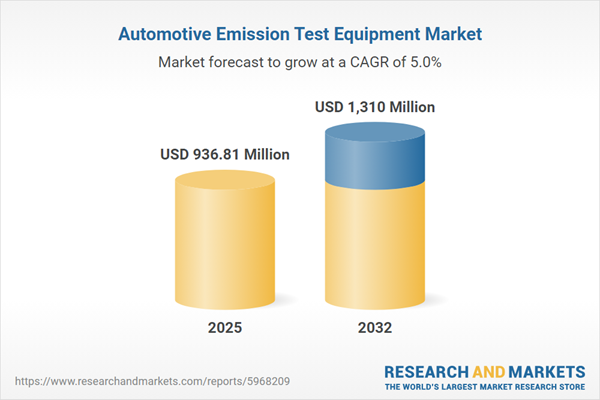Speak directly to the analyst to clarify any post sales queries you may have.
The automotive emission test equipment market stands at the forefront of regulatory compliance and technological advancement, ensuring automotive leaders can address increasingly complex environmental standards and evolving powertrain technologies.
Market Snapshot: Automotive Emission Test Equipment Market Size and Growth
The global automotive emission test equipment market reached a value of USD 891.89 million in 2024, supported by a compound annual growth rate (CAGR) of 4.97%. Market projections anticipate growth to USD 936.81 million by 2025 and USD 1.31 billion by 2032. Stricter worldwide emissions mandates, ongoing powertrain test infrastructure modernization, and a shift to digital management solutions fuel this growth. Regulatory bodies are updating standards frequently, prompting manufacturers and service providers to invest in advanced analytics and technology to maintain market leadership and compliance across all regions.
Scope & Segmentation: Strategic Overview of the Automotive Emission Test Equipment Market
This comprehensive report delivers actionable insights for senior executives, outlining the most relevant product categories, test methodologies, end-user groups, and global application areas within the automotive emission test equipment market. Clear intelligence helps leaders target investments and streamline compliance initiatives in a changing regulatory space.
- Product Types: Chassis dynamometers, dilution systems, emission analyzers, gas analyzers, particulate matter analyzers, and smoke meters each fulfill distinct roles in ensuring vehicles meet regional and international emissions standards.
- Test Methods: Cold start analysis, endurance testing, transient cycle testing, real driving emissions evaluation, and regulatory audits provide the framework for emissions quantification in both laboratory and operational settings during all stages of vehicle development.
- End Users: Aftermarket service providers, original equipment manufacturers (OEMs), emissions laboratories, and research institutions depend on certified tools to validate technology, ensure ongoing compliance, and drive advancements in automotive innovation.
- Fuel Types: Test equipment is engineered for diesel, gasoline, hybrid, hydrogen, and natural gas vehicles, accommodating the shift toward low-carbon propulsion and evolving emissions targets.
- Distribution Channels: Direct sales, authorized distributors, and digital procurement portals support broad market accessibility and rapid deployment across both established and emerging markets.
- Regions: The Americas, Europe, Middle East & Africa, and Asia-Pacific offer diverse opportunities for technology adoption, driven by local infrastructure maturity and regulatory requirements.
- Key Companies: Leading global providers such as HORIBA Ltd., AVL List GmbH, MAHA Maschinenbau Haldenwang GmbH & Co. KG, Testo SE & Co. KGaA, Environmental Systems Products Inc., TSI Incorporated, Thermo Fisher Scientific Inc., KANE International Ltd., Opus Inspection Limited, and California Analytical Instruments Inc. underpin market reliability and adherence to international standards.
Key Takeaways: Strategic Insights for Senior Decision-Makers
- Portable emissions analyzers increase operational flexibility, empowering compliance teams to perform high-precision tests both in laboratory and on-site environments, resulting in broader environmental monitoring.
- Compatibility across multiple powertrain systems enables organizations to efficiently address evolving vehicle technologies and integrate new propulsion solutions without operational disruption.
- The adoption of digital twin solutions and advanced analytics drives improved process transparency, supports predictive diagnostics, and enables more proactive asset maintenance to maximize equipment uptime.
- Reinforcing local supplier networks and regional assembly operations enhances supply chain agility, reduces exposure to regulatory shifts, and mitigates the risk of critical part shortages.
- Building internal expertise and continuous engagement with regulatory bodies establishes an agile compliance approach, promoting swift organizational response to policy changes and high standards for workforce competence.
Tariff Impact: Navigating Shifting Supply Chain Challenges
Shifting tariff regulations, especially in the United States, are prompting emission test equipment providers to diversify their supplier base, reposition assembly closer to end-user markets, and review sourcing alternatives. These strategic measures are critical for reducing exposure to supply chain disruptions and ensuring steady access to advanced emission testing solutions.
Methodology & Data Sources
This report’s insights are generated from structured interviews with automotive industry professionals, detailed analyses of technical documents, and rigorous market trend validation. These steps ensure a thorough foundation for procurement strategies and informed technology implementation.
Why This Report Matters
- Enables executive teams to anticipate operational and compliance impacts from regulatory and technology developments within the automotive sector.
- Supports adoption of new emissions testing solutions that align with emerging vehicle technologies, maintaining organizational competitiveness.
- Equips leaders to strengthen supply chains and adapt sourcing strategies to evolving global challenges and market conditions.
Conclusion
Applying the insights in this report empowers senior decision-makers to strengthen compliance, support operational improvements, and strategically prepare for ongoing change in the automotive emissions market.
Additional Product Information:
- Purchase of this report includes 1 year online access with quarterly updates.
- This report can be updated on request. Please contact our Customer Experience team using the Ask a Question widget on our website.
Table of Contents
3. Executive Summary
4. Market Overview
7. Cumulative Impact of Artificial Intelligence 2025
Companies Mentioned
The companies profiled in this Automotive Emission Test Equipment market report include:- HORIBA, Ltd.
- AVL List GmbH
- MAHA Maschinenbau Haldenwang GmbH & Co. KG
- Testo SE & Co. KGaA
- Environmental Systems Products, Inc.
- TSI Incorporated
- Thermo Fisher Scientific Inc.
- KANE International Ltd.
- Opus Inspection Limited
- California Analytical Instruments, Inc.
Table Information
| Report Attribute | Details |
|---|---|
| No. of Pages | 197 |
| Published | October 2025 |
| Forecast Period | 2025 - 2032 |
| Estimated Market Value ( USD | $ 936.81 Million |
| Forecasted Market Value ( USD | $ 1310 Million |
| Compound Annual Growth Rate | 4.9% |
| Regions Covered | Global |
| No. of Companies Mentioned | 11 |









